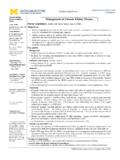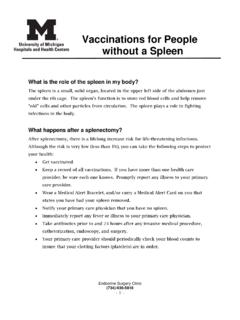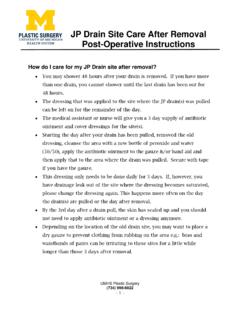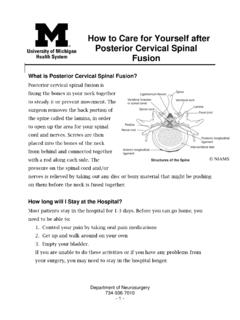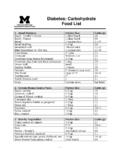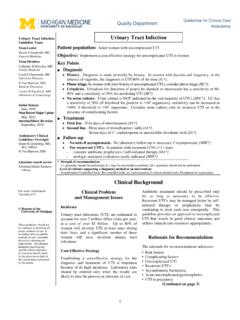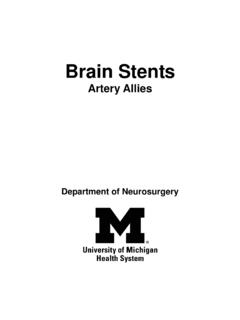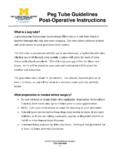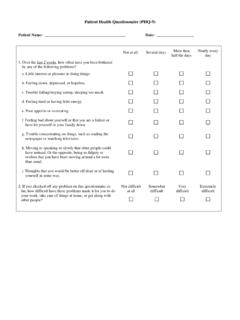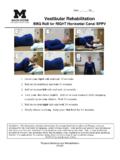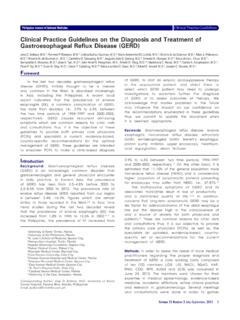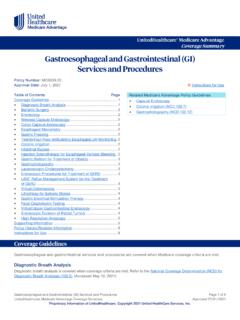Transcription of GERD Gastroesophageal Reflux Disease (GERD) Guideline …
1 1 Quality Department Guidelines for Clinical Care Ambulatory GERD Guideline Team Team Leader Joel J Heidelbaugh, MD Family Medicine Team Members R Van Harrison, PhD Learning Health Sciences Mark A McQuillan, MD General Medicine Timothy T Nostrant, MD Gastroenterology Initial Release March 2002 Most Recent Major Update May 2012 Content Reviewed March 2018 Ambulatory Clinical Guidelines Oversight Karl T Rew, MD R Van Harrison, PhD Literature search service Taubman Health Sciences Library For more information 734-936-9771 Regents of the University of Michigan These guidelines should not be construed as including all proper methods of care or excluding other acceptable methods of care reasonably directed to obtaining the same results. The ultimate judgment regarding any specific clinical procedure or treatment must be made by the physician in light of the circumstances presented by the patient. Gastroesophageal Reflux Disease (GERD) Patient population: Adults Objective: To implement a cost-effective and evidence-based strategy for the diagnosis and treatment of Gastroesophageal Reflux Disease (GERD).
2 Key Points: Diagnosis History. If classic symptoms of heartburn and acid regurgitation dominate a patient s history, then they can help establish the diagnosis of GERD with sufficiently high specificity, although sensitivity remains low compared to 24-hour pH monitoring. The presence of atypical symptoms (Table 1), although common, cannot sufficiently support the clinical diagnosis of GERD [B*]. Testing. No gold standard exists for the diagnosis of GERD [A*]. Although 24-hour pH monitoring is accepted as the standard with a sensitivity of 85% and specificity of 95%, false positives and false negatives still exist [II B*]. Endoscopy lacks sensitivity in determining pathologic Reflux but can identify complications (eg, strictures, erosive esophagitis, Barrett s esophagus) [I A]. Barium radiography has limited usefulness in the diagnosis of GERD and is not recommended [III B*]. Therapeutic trial. An empiric trial of anti-secretory therapy can identify patients with GERD who lack alarm or warning symptoms (Table 2) [I A*] and may be helpful in the evaluation of those with atypical manifestations of GERD, specifically non-cardiac chest pain [II B*].
3 Treatment Lifestyle modifications. Lifestyle modifications (Table 3) should be recommended throughout the treatment of GERD [II B], yet there is evidence-based data to support only weight loss and avoiding recumbency several hours after meals [II C*]. Pharmacologic treatment. H2-receptor antagonists (H2 RAs), proton pump inhibitors (PPIs), and prokinetics have proven efficacy in the treatment of GERD [I A*]. Prokinetics are as effective as H2 RAs but are currently unavailable [III A*]. Carafate and antacids are ineffective [III A*], but may be used as supplemental acid-neutralizing agents for certain patients with GERD [II D*]. Non-erosive Reflux Disease (NERD): Step-up (H2RA, then a PPI if no improvement) and step-down (PPI, then the lowest dose of acid suppression) therapy are equally effective for acute treatment and maintenance [I B*]. On demand (patient-directed) therapy is the most cost-effective [I B]. Erosive esophagitis: Initial PPI therapy is the treatment of choice for acute and maintenance therapy for patients with documented erosive esophagitis [I A*].
4 Take PPIs 30-60 minutes prior to breakfast (and also dinner if taking twice daily) to optimize effectiveness [I B*]. Use generic and OTC formulations exclusively, eliminating need for prior authorizations. Patients should not be left on anti-secretory therapy without re-evaluation of symptoms to minimize cost and the potential adverse events from medications [I B]. Surgery. Anti- Reflux surgery is an alternative modality in GERD treatment for patients with chronic Reflux and recalcitrant symptoms [II A*], yet has a significant complication rate (10-20%). Resumption of pre-operative medication treatment is common (> 50%) and may increase over time. Other endoscopic treatments. While less invasive and with fewer complications, they have lower response rates than anti- Reflux surgery [II C*], and have not been shown to reduce acid exposure. Follow up Symptoms unchanged. If symptoms remain unchanged in a patient with a prior normal endoscopy, repeating endoscopy has no benefit and is not recommended [III C*].
5 Warning signs. Patients with warning or alarm signs and symptoms suggesting complications from GERD (Table 2) should be referred to a GERD specialist. Risk for complications. Further diagnostic testing (eg, EGD [esophagogastroduodenoscopy], 24-hour pH monitoring) should be considered in patients who do not respond to acid suppression therapy [I C*] and in patients with a chronic history of GERD who are at risk for complications. Chronic Reflux has been suspected to play a major role in the development of Barrett s esophagus, yet it is unknown if outcomes can be improved through surveillance and medical treatment [D*]. * Strength of recommendation: I = generally should be performed; II = may be reasonable to perform; III = generally should not be performed. Level of evidence supporting a diagnostic method or an intervention: A=randomized controlled trials; B=controlled trials, no randomization; C=observational trials; D=opinion of expert panel. 2 UMHS GERD Guideline , September, 2013 Figure 1.
6 Diagnosis and Treatment of GERD Table 1. Atypical Signs of GERD Table 2. Alarm or Warning Signs Suggesting Complicated GERD Table 3. Lifestyle Modifications Chronic cough Elevate head of bed 6-8 inches Asthma Dysphagia Decrease fatty meals Recurrent sore throat Odynophagia Stop smoking Recurrent laryngitis GI bleeding Avoid recumbency or sleeping for 3-4 hours after eating Dental enamel loss Iron deficiency anemia Avoid certain foods: chocolate, alcohol, peppermint, caffeinated coffee and other beverages, onions, garlic, fatty foods, citrus, tomato Subglottic stenosis Weight loss Globus sensation Early satiety Avoid large meals Chest pain Vomiting Weight loss Onset of symptoms at age > 50 Avoid medications that can potentiate symptoms: calcium channel blockers, beta-agonists, alpha-adrenergic agonists, theophylline, nitrates, and some sedatives (benzodiazepines). 3 UMHS GERD Guideline , September, 2013 Table 4. Medications for Acute Treatment and Maintenance Regimens Drug Dose Equivalents a Dosage b OTC Generic c Brand c H2 receptor antagonists cimetidine (Tagamet HB) 200 mg twice daily 200 mg twice daily $25 $25 NA cimetidine (Tagamet) 400 mg twice daily 400 mg twice daily $12 $25 NA famotidine (Pepcid) 20 mg twice daily 20 mg twice daily $11 $9 $655 nizatidine (Axid) 150 mg twice daily 150 mg twice daily $43 $37 NA Proton pump inhibitors dexlansoprazole (Dexilant) 30 mg daily 30 mg once daily NA NA $296 esomeprazole (Nexium) 20 mg daily 20 to 40 mg daily $25-34 $22-27 $271 lansoprazole (Prevacid) 30 mg daily 15 or 30 mg daily before breakfast $15-29 $15-24 $448 omeprazole (Prilosec) 20 mg daily 20 or 40 mg daily before breakfast $15-30 $5-8 NA pantoprazole (Protonix) 40 mg daily 40 mg daily before breakfast NA $6 $465 rabeprazole (Aciphex)
7 20 mg daily 20 mg daily before breakfast NA $21 $567 a For each drug, the dose listed in this column has an effect similar to the doses listed in this column for other drugs. b Maximum GERD dose for PPIs except dexlansoprazole is the highest listed dose amount, but given twice daily before breakfast and before dinner. Dexlansoprazole maximum dose is 60 mg once daily. c Cost = For brand drugs, Average Wholesale Price minus 10%. AWP from Red Book Online 4/3/18. For generic drugs, Maximum Allowable Cost plus $3 from BCBS of Michigan MAC List, 4/1/18. Prices calculated for 30-day supply unless otherwise noted. Clinical Background Clinical Problem Incidence Gastroesophageal Reflux Disease (GERD) is a common chronic, relapsing condition that carries a risk of significant morbidity and potential mortality from resultant complications. While many patients self-diagnose, self-treat and do not seek medical attention for their symptoms, others suffer from more severe Disease with esophageal damage ranging from erosive to ulcerative esophagitis.
8 More than 60 million adult Americans suffer from heartburn at least once a month, and over 25 million experience heartburn daily. The National Ambulatory Medical Care Survey (NAMCS) found that million annual adult outpatient visits were related to GERD. For patients presenting with GERD symptoms, 40-60% or more have Reflux esophagitis. Up to 10% of these patients will have erosive esophagitis on upper endoscopy. GERD is more prevalent in pregnant women, and a higher complication rate exists among the elderly. Patients with GERD generally report decreases in productivity, quality of life and overall well-being. Many patients rate their quality of life to be lower than that reported by patients with untreated angina pectoris or chronic heart failure. GERD is a risk factor for the development of esophageal adenocarcinoma, further increasing the importance of its diagnosis and treatment.
9 Extraesophageal manifestations associated with GERD occur in up to 50% of patients with non-cardiac chest pain, 78% of patients with chronic hoarseness, and 82% of patients with asthma. Over 50% of patients with GERD have no endoscopic evidence of Disease . Although these diagnostic limitations occur less often when patients present with the classic symptoms of heartburn and acid regurgitation, diagnosis may be difficult in patients with recalcitrant courses and extraesophageal manifestations of this Disease . Diagnostic Problems The lack of a gold standard in the diagnosis of GERD presents a clinical dilemma in treating patients with Reflux symptomatology. Many related syndromes including dyspepsia, atypical GERD, H. pylori-induced gastritis, peptic ulcer Disease and gastric cancer may present similarly, making accurate history taking important. The most common referral to a gastroenterologist from primary care is for evaluation of refractory GERD.
10 Even in these cases the pre-test sensitivity and specificity for accurate diagnosis remain low. Invasive testing is over-utilized and not always cost-effective, given the relatively small risk of misdiagnosis based upon an accurate patient history. Empiric pharmacotherapy is advantageous based on both cost and convenience for the patient. Treatment Decision Problems Although empiric anti-secretory therapy with a histamine-2 receptor antagonist (H2RA) or a proton pump inhibitor (PPI) provides symptomatic relief from heartburn and regurgitation in most cases, the potential long-term adverse effects of anti- Reflux medications are unknown. No cases of gastric cancer or carcinoid linked to use of the PPIs have been reported since the advent of this class of medication over 20 years ago. 4 UMHS GERD Guideline , September, 2013 Complications from GERD (eg, Barrett s esophagus, adenocarcinoma of the esophagus) are rare but do exist; 10-15% with GERD will develop Barrett s esophagus, and 1-10% of those with Barrett s will develop adenocarcinoma over 10-20 years.
